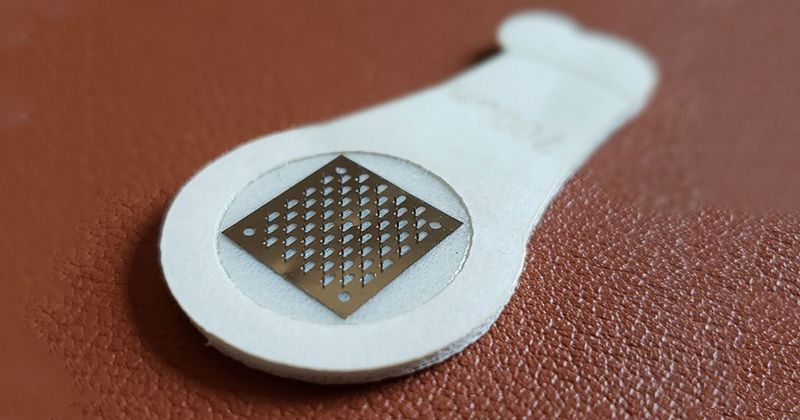Microneedle patch shows potential as option for peanut immunotherapy
Peanut-coated microneedles may represent a safe and effective alternative to epicutaneous immunotherapy, according to a study published in Immunotherapy.
“With only one FDA-approved treatment available for patients with food allergies, there remains a significant need to develop new treatment options,” Jessica O’Konek, PhD, research assistant professor at Michigan Medicine Mary H. Weiser Food Allergy Center, told Healio.


“The hypothesis driving this work is that targeting allergen into the skin with a minimally invasive microneedle patch will allow for delivery of allergen to the immune cells in the skin, ultimately resulting in desensitization to the food,” continued O’Konek, who also is a research investigator in the Michigan Nanotechnology Institute for Medicine and Biological Sciences.
The study aimed to determine the efficacy of peanut-coated microneedle patches in peanut allergy while directly comparing this approach with epicutaneous immunotherapy (EPIT) with peanut following the same schedule, O’Konek said.
The study and its results
Researchers at Michigan Medicine collaborated with Moonlight Therapeutics to develop 1 cm by 1 cm arrays of 50 microneedles each measuring 700 μm long, with each array coated in a formulation including 11.3 ± 0.9 μg (standard deviation, 4) of peanut protein.
The researchers inserted these peanut-coated microneedles (PN-MN) into the hairless skin of female mice that had already been sensitized to peanuts and held them in place for 5 minutes to allow the protein to dissolve inside the skin. Also, microneedles coated with ovalbumin (OVA-MN) were prepared as a microneedle control.
For comparison with EPIT, the researchers deposited a peanut extract solution on a 1 cm by 1 cm patch of sterile gauze that was placed on the depilated skin of other sensitized female mice with bio-occlusive dressing (PN-EPIT). Similar gauze treated with phosphate-buffered saline (PBS) was used as a control. The gauze was kept on the skin for 24 hours.
All treatments were administered once a week for 5 weeks. During the final 2 weeks, the mice received peanut oral challenges on 7 alternating days and were monitored for reactivity for up to an hour after each challenge. Mice were bled an hour after each challenge as well, and ELISA was used to determine serum concentrations of mouse mast cell protease-1 (MCPT-1).
All the mice in the control groups showed allergic symptoms. However, 90% of the mice that received PN-MN treatment showed no allergic symptoms.
Also, the mice that received PN-MN treatment experienced significant reductions in MCPT-1. The researchers said this suppression of reactivity was allergen-specific, because the mice receiving OVA-MN treatment did not see any similar effects.
The mice that received PN-EPIT treatment did not show any evidence of desensitization and continued to experience reduced body temperature, MCPT-1 release and similar clinical symptoms to what the control groups experienced after 5 weeks, but significant suppression of reactivity was observed after 8 or 12 weeks of treatment.
Additionally, the Th2 cytokines IL-4 and IL-5 in lymphocytes from the mesenteric lymph nodes (mLN) were suppressed while IL-10 and IFN-gamma increased in the mice receiving PN-MN treatment compared with the controls. IL-21, which promotes allergic disease, decreased in the mLN of the mice in the PN-MN group as well.
The implications of the findings
To the researchers’ knowledge, this is the first report comparing the efficacy of allergen immunotherapy delivered by coated microneedle patches with allergen applied epicutaneously.
“While our work is thus far only in a mouse model, it showed suppression of allergic reactivity with only 5 weekly treatments, each lasting only 5 minutes,” O’Konek said.
“This suggests that delivery of the peanut protein into the skin with the microneedle patches may accelerate desensitization or allow for efficacy with more limited duration of treatment as compared with other allergen-specific immunotherapy approaches,” she said.
Overall, the researchers cited the minimally invasive nature of microneedles and how they are well-tolerated by patients with pain-free application. They also deliver antigen directly into the skin compared with EPIT treatment, with no variability due to the strength of the barrier or passive diffusion requirements.
According to the researchers, the microneedles delivered 65.1% of the peanut protein formulation directly into the skin, whereas 28.1% remained on the microneedles and 6.8% remained on the surface. Yet the amount of allergen delivered into the skin with EPIT is unknown, the researchers said.
“Delivery of allergens via microneedles should allow for more controlled delivery of allergen into the skin. Additionally, this approach should not be affected by differences in skin barrier,” O’Konek said.
The PN-MN treatment also did not produce any erythema, inflammation, reactivity or mast cell degranulation after insertion, although the researchers cautioned that clinical trials will be critical for demonstrating similar safety profiles in humans.
Based on its safety and efficacy, the researchers concluded, microneedle treatment may present a novel mechanism for improving cutaneous immunotherapy and in administering next-generation therapeutics for treating peanut and other food allergies.
Moonlight Therapeutics, which is developing the peanut-coated microneedle patches, is now planning the first clinical trial of this approach in humans.
“While we did not directly compare this microneedle approach with other immunotherapies, having another treatment option would be a significant advantage, for example, in instances where patients cannot tolerate daily eating of their allergenic foods,” O’Konek said.
Reference:
- Microneedle approach to address peanut allergy shows promise in mice. https://labblog.uofmhealth.org/health-tech/microneedle-approach-to-address-peanut-allergy-shows-promise-mice. Published March 4, 2022. Accessed March 14, 2022.
